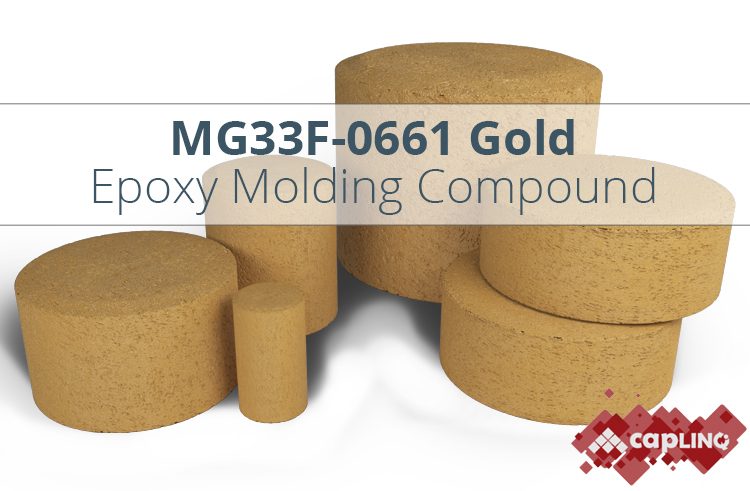Hysol MG33F-0661 | Gold Epoxy Mold Compound
- Environment friendly molding compound
- Very low moisture absorption
- Identical to MG33F-0660
Product Description
Hysol MG33F-0661 is a gold, semiconductor-grade epoxy molding compound or duroplast designed for the encapsulation and protection of tantalum capacitors. Because of its fast cure, it is also very well suited for the manufacture of reed relays.
Hysol MG33F-0661 was formulated with a short gel time to make it useful for automolding tantalum capacitors and reed relays.It is an environmentally friendly "green" molding compound which contains no bromine, antimony or phosphorus flame retardant. MG33F-0661 molding compound was developed specifically for the encapsulation of tantalum capacitors in automold applications. MG33F-0661 meets UL 94 V-0 Flammability at 6.35mm thickness.
You might be wondering, "But what's the difference between this one and MG33F-0660?" Short answer. Nothing. Back in the day, SKUs were not ideal so this is a customer specific SKU for the exact same product. Why is this here then? Maybe you ARE that customer looking for it. You are welcome.
Technical Specifications
| General Properties | |
| Color Color The color | Gold |
| Filler Content | 72 % |
| Specific Gravity Specific Gravity Specific gravity (SG) is the ratio of the density of a substance to the density of a reference substance; equivalently, it is the ratio of the mass of a substance to the mass of a reference substance for the same given volume. For liquids, the reference substance is almost always water (1), while for gases, it is air (1.18) at room temperature. Specific gravity is unitless. | 1.81 |
| Chemical Properties | |
| Moisture absorption | 0.42 % |
| Physical Properties | |
| Spiral Flow @ 175°C | 27 cm |
| Thermal Properties | |
| Glass Transition Temperature (Tg) Glass Transition Temperature (Tg) The glass transition temperature for organic adhesives is a temperature region where the polymers change from glassy and brittle to soft and rubbery. Increasing the temperature further continues the softening process as the viscosity drops too. Temperatures between the glass transition temperature and below the decomposition point of the adhesive are the best region for bonding. The glass-transition temperature Tg of a material characterizes the range of temperatures over which this glass transition occurs. | 164 °C |
| Thermal Conductivity Thermal Conductivity Thermal conductivity describes the ability of a material to conduct heat. It is required by power packages in order to dissipate heat and maintain stable electrical performance. Thermal conductivity units are [W/(m K)] in the SI system and [Btu/(hr ft °F)] in the Imperial system. | 0.8 W/m.K |
| UL 94 Rating UL 94 Rating Flammability rating classification. It determines how fast a material burns or extinguishes once it is ignited. HB: slow burning on a horizontal specimen; burning rate less than 76 mm/min for thickness less than 3 mm or burning stops before 100 mm V-2: burning stops within 30 seconds on a vertical specimen; drips of flaming particles are allowed. V-1: burning stops within 30 seconds on a vertical specimen; drips of particles allowed as long as they are not inflamed. V-0: burning stops within 10 seconds on a vertical specimen; drips of particles allowed as long as they are not inflamed. 5VB: burning stops within 60 seconds on a vertical specimen; no drips allowed; plaque specimens may develop a hole. 5VA: burning stops within 60 seconds on a vertical specimen; no drips allowed; plaque specimens may not develop a hole | V0 |
| Electrical Properties | |
| Dielectric Strength Dielectric Strength Dielectric strength is measured in kV per mm and is calculated by the Breakdown voltage divided by the thickness of the tested material. Those two properties go hand in hand and while Breakdown voltage is always thickness dependent, dielectric strength is a general material property. As an example, the dielectric strength of Polyimide is 236 kV/mm. If we place 1mm of Polyimide between two electrodes, it will act as an insulator until the voltage between the electrodes reaches 236 kV. At this point it will start acting as a good conductor, causing sparks, potential punctures and current flow. | 37 kV/mm |
| Volume Resistivity Volume Resistivity Volume resistivity, also called volume resistance, bulk resistance or bulk resistivity is a thickness dependent measurement of the resistivity of a material perpendicular to the plane of the surface. | 2.6x1015 Ohms⋅cm |
| Curing Conditions | |
| Transfer Pressure | 40 - 80 kg/cm2 |
| Transfer Time | 5 - 10 s |




